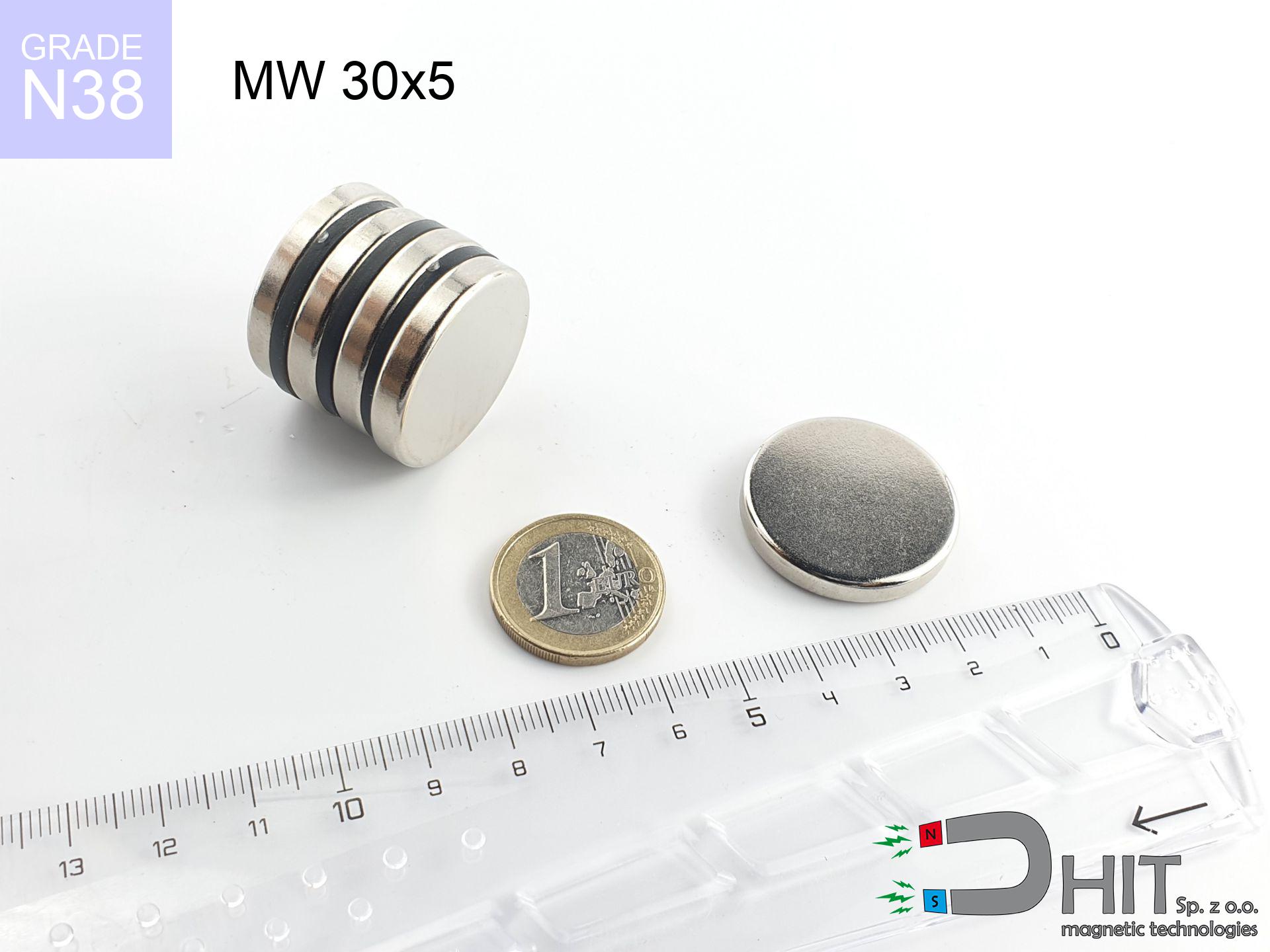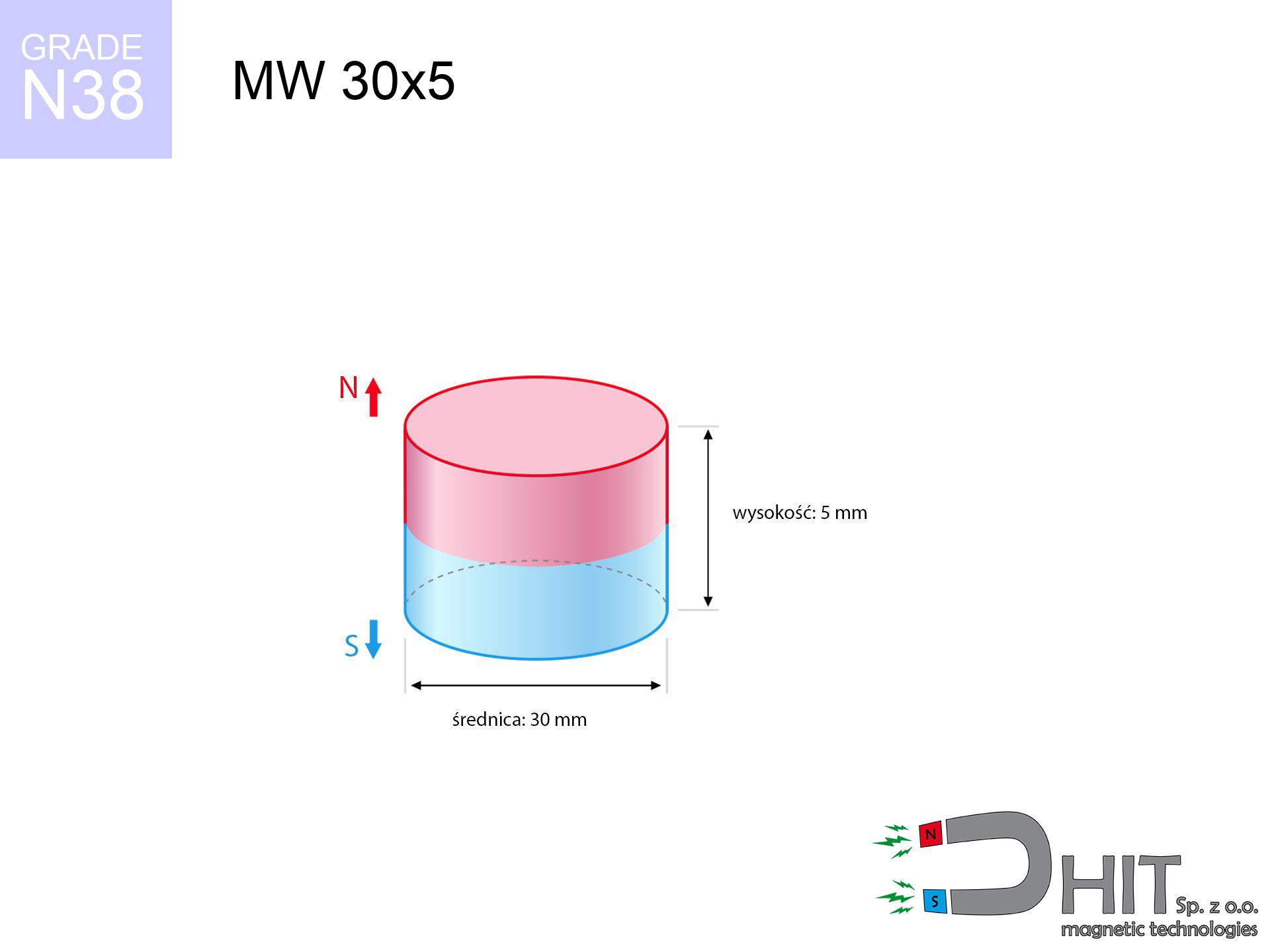MW 30x5 / N38 - cylindrical magnet
cylindrical magnet
Catalog no 010056
GTIN: 5906301810551
Diameter Ø
30 mm [±0,1 mm]
Height
5 mm [±0,1 mm]
Weight
26.51 g
Magnetization Direction
↑ axial
Load capacity
8.29 kg / 81.3 N
Magnetic Induction
196.02 mT
Coating
[NiCuNi] nickel
9.59 ZŁ with VAT / pcs + price for transport
7.80 ZŁ net + 23% VAT / pcs
bulk discounts:
Need more?Can't decide what to choose?
Contact us by phone
+48 888 99 98 98
otherwise let us know through
contact form
our website.
Parameters as well as shape of magnets can be reviewed using our
modular calculator.
Same-day shipping for orders placed before 14:00.
Magnetic properties of material N38
Physical properties of sintered neodymium magnets Nd2Fe14B at 20°C
Shopping tips
Advantages as well as disadvantages of neodymium magnets.
Besides their durability, neodymium magnets are valued for these benefits:
- They virtually do not lose power, because even after 10 years the performance loss is only ~1% (in laboratory conditions),
- They feature excellent resistance to magnetism drop due to external magnetic sources,
- The use of an refined layer of noble metals (nickel, gold, silver) causes the element to be more visually attractive,
- Magnets possess exceptionally strong magnetic induction on the outer side,
- Neodymium magnets are characterized by very high magnetic induction on the magnet surface and can function (depending on the shape) even at a temperature of 230°C or more...
- Considering the potential of accurate shaping and adaptation to specialized projects, magnetic components can be manufactured in a wide range of shapes and sizes, which amplifies use scope,
- Universal use in electronics industry – they are used in data components, electromotive mechanisms, precision medical tools, and multitasking production systems.
- Relatively small size with high pulling force – neodymium magnets offer strong magnetic field in compact dimensions, which makes them useful in miniature devices
Cons of neodymium magnets: weaknesses and usage proposals
- They are fragile upon heavy impacts. To avoid cracks, it is worth securing magnets in a protective case. Such protection not only shields the magnet but also increases its resistance to damage
- NdFeB magnets lose strength when exposed to high temperatures. After reaching 80°C, many of them experience permanent drop of strength (a factor is the shape as well as dimensions of the magnet). We offer magnets specially adapted to work at temperatures up to 230°C marked [AH], which are extremely resistant to heat
- Due to the susceptibility of magnets to corrosion in a humid environment, we advise using waterproof magnets made of rubber, plastic or other material resistant to moisture, in case of application outdoors
- We suggest casing - magnetic mount, due to difficulties in creating threads inside the magnet and complex shapes.
- Potential hazard related to microscopic parts of magnets can be dangerous, in case of ingestion, which gains importance in the context of child health protection. Additionally, tiny parts of these magnets can be problematic in diagnostics medical after entering the body.
- Higher cost of purchase is a significant factor to consider compared to ceramic magnets, especially in budget applications
Maximum lifting force for a neodymium magnet – what it depends on?
The lifting capacity listed is a result of laboratory testing executed under the following configuration:
- with the contact of a sheet made of special test steel, guaranteeing full magnetic saturation
- possessing a massiveness of minimum 10 mm to avoid saturation
- characterized by lack of roughness
- under conditions of no distance (surface-to-surface)
- under perpendicular force direction (90-degree angle)
- at ambient temperature room level
What influences lifting capacity in practice
During everyday use, the actual lifting capacity results from many variables, ranked from crucial:
- Gap (between the magnet and the plate), because even a microscopic clearance (e.g. 0.5 mm) leads to a drastic drop in force by up to 50% (this also applies to varnish, corrosion or debris).
- Load vector – highest force is reached only during perpendicular pulling. The resistance to sliding of the magnet along the surface is typically many times smaller (approx. 1/5 of the lifting capacity).
- Element thickness – for full efficiency, the steel must be sufficiently thick. Thin sheet restricts the attraction force (the magnet "punches through" it).
- Material type – ideal substrate is high-permeability steel. Hardened steels may have worse magnetic properties.
- Smoothness – ideal contact is obtained only on polished steel. Rough texture reduce the real contact area, reducing force.
- Thermal factor – hot environment weakens magnetic field. Too high temperature can permanently demagnetize the magnet.
* Lifting capacity was measured using a smooth steel plate of suitable thickness (min. 20 mm), under vertically applied force, whereas under parallel forces the load capacity is reduced by as much as 75%. Additionally, even a slight gap {between} the magnet’s surface and the plate lowers the load capacity.
Safe handling of neodymium magnets
Crushing force
Watch your fingers. Two large magnets will join immediately with a force of several hundred kilograms, crushing everything in their path. Exercise extreme caution!
Magnetic media
Device Safety: Neodymium magnets can damage data carriers and sensitive devices (heart implants, hearing aids, timepieces).
Danger to pacemakers
Health Alert: Strong magnets can deactivate pacemakers and defibrillators. Stay away if you have medical devices.
Threat to navigation
An intense magnetic field interferes with the functioning of magnetometers in phones and navigation systems. Do not bring magnets near a device to prevent breaking the sensors.
Handling rules
Handle magnets with awareness. Their immense force can shock even experienced users. Be vigilant and respect their power.
Skin irritation risks
Nickel alert: The nickel-copper-nickel coating consists of nickel. If skin irritation appears, immediately stop handling magnets and use protective gear.
Product not for children
Neodymium magnets are not suitable for play. Swallowing a few magnets can lead to them connecting inside the digestive tract, which constitutes a direct threat to life and necessitates immediate surgery.
Fragile material
NdFeB magnets are ceramic materials, meaning they are prone to chipping. Impact of two magnets leads to them breaking into small pieces.
Mechanical processing
Machining of neodymium magnets poses a fire hazard. Magnetic powder oxidizes rapidly with oxygen and is difficult to extinguish.
Power loss in heat
Avoid heat. NdFeB magnets are susceptible to heat. If you require operation above 80°C, ask us about special high-temperature series (H, SH, UH).
Danger!
Learn more about risks in the article: Safety of working with magnets.





![SM 25x300 [2xM8] / N52 - magnetic separator SM 25x300 [2xM8] / N52 - magnetic separator](https://cdn3.dhit.pl/graphics/products/sm-25x300-2xm8-dij.jpg)
![SM 32x250 [2xM8] / N42 - magnetic separator SM 32x250 [2xM8] / N42 - magnetic separator](https://cdn3.dhit.pl/graphics/products/sm-32x250-2xm8-kex.jpg)


